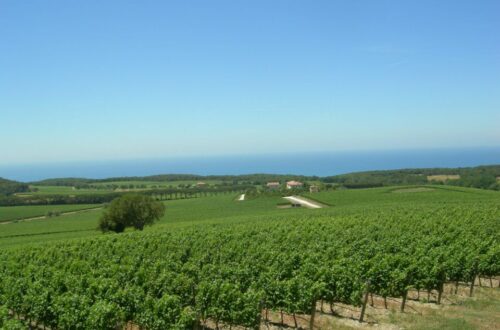Table of Contents
What Is Cagliari DOC Wine?
Cagliari DOC is one of Sardinia’s most historic and versatile wine appellations, stretching along the island’s sunlit southern coast. Celebrated for its Malvasia-based whites, Monica reds, Vermentino blends, and lively Spumante, this DOC captures the Mediterranean character of Sardinia: salt-kissed breezes, abundant sunshine, and a winemaking tradition dating back millennia.
History of Cagliari Winemaking
The story of Cagliari’s wines is as old as the city itself. Ancient Phoenicians and Romans used the port of Cagliari to export amphorae of local wine across the Mediterranean. By the Middle Ages, the wines of Sardinia were already prized in trade, with Cagliari at the center of cultural and commercial exchange. Today, the DOC remains a bridge between past and present, where ancient grape varieties thrive under modern DOC regulations.
Geography & Terroir of Cagliari DOC
Cagliari lies on Sardinia’s southern coastline, where vineyards sprawl from coastal plains to rolling inland hills. The terroir is defined by:
- Soils: Limestone, clay, and sandy deposits shaped by ancient marine influence.
- Climate: Warm Mediterranean with cooling sea breezes that preserve freshness.
- Exposures: Sun-drenched slopes that favor ripeness yet retain balance.
This combination creates wines that are both bold in flavor and marked by a signature maritime salinity.
Cagliari DOC Grapes & Wine Styles
Cagliari DOC regulations allow a remarkable diversity of styles, reflecting Sardinia’s unique grape heritage.
- Whites: Malvasia di Sardegna, Vermentino, and Nasco
- Reds: Monica (the star red grape), Cannonau, Carignano
- Spumante: Sparkling wines crafted from native whites, offering fresh, citrus-driven effervescence
Winemaking Rules & DOC Requirements
The Cagliari DOC was officially established in 1979, setting standards for style and authenticity. Key regulations include:
- Whites & Rosés: Minimum 11% ABV
- Reds: Minimum 11.5% ABV
- Riserva Wines: Extended aging of at least 2 years (with 6 months in wood)
- Spumante: Produced using both Charmat and traditional methods, highlighting freshness
Key Facts at a Glance
- Region: Southern Sardinia
- Established: 1979
- Primary Grapes: Malvasia, Monica, Vermentino, Nasco, Cannonau
- Styles: White, Rosato, Red, Spumante
- Climate: Warm Mediterranean with cooling sea influence
Tasting Notes by Style
| Style | Tasting Profile |
| Malvasia White | Floral, honeyed, with Mediterranean herbs and citrus zest |
| Monica Red | Soft tannins, red cherry, dried herbs, a touch of spice |
| Vermentino White | Crisp acidity, notes of lime, green apple, and sea breeze salinity |
| Spumante | Light, sparkling, with citrus, almond, and coastal minerality |
Serving Temperatures & Pairing Ideas
- Malvasia & Vermentino Whites: Serve chilled (8–10°C) with seafood pasta, grilled prawns, or pecorino cheese.
- Monica Red: Serve slightly cool (14–16°C) with roast lamb, tomato-based pasta, or pizza.
- Spumante: Ideal aperitivo at 6–8°C, paired with fried calamari or light antipasti.
Where to Buy Cagliari DOC Wines
Cagliari DOC wines can be found through:
- Specialty Italian wine shops in Europe and North America
- Online retailers like Wine.com, Vivino, and Eataly
- On the ground, at Sardinia’s cantine and enotecas in Cagliari and surrounding coastal towns
Pricing is approachable, with many bottles ranging €12–20, while Riservas and top expressions can reach €30–40.
FAQs About Cagliari DOC
Is Monica grape unique to Sardinia?
Yes. Monica is one of Sardinia’s heritage reds, soft yet characterful, and rarely grown elsewhere.
What food pairs best with Cagliari DOC wines?
Seafood with the whites, roasted meats with the reds, and aperitivo-style snacks with Spumante.
Are Cagliari DOC wines easy to find outside Italy?
While less common than Vermentino di Sardegna, many importers carry them thanks to Sardinia’s growing wine tourism appeal.
Cultural Highlights & Fun Facts
- Easter Traditions: Cagliari’s Holy Week processions are often accompanied by communal feasts where local wines are poured.
- Sardinian Hospitality: The phrase a chent’annos (“to a hundred years”) is a typical toast, reflecting Sardinia’s famed longevity.
- Roman Legacy: Amphorae of Sardinian wine found in shipwrecks near Cagliari confirm its role in ancient Mediterranean trade.
Call to Action
🍷 Curious to experience Sardinia in a glass? Explore more about Vermentino di Sardegna DOC and Cannonau di Sardegna DOC to see how Cagliari connects to the island’s broader wine heritage.
Join the Drink Italian community newsletter for insider guides, tasting notes, and travel inspiration straight from Italy’s vineyards to your inbox.


